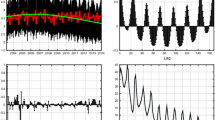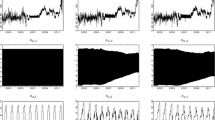Abstract
There are several approaches in the literature for the derivation of price forward curves (PFCs) which distinguish among each other by the procedure employed for the derivation of seasonality shapes, smoothing technique and by the design of the optimization procedure. However, a comparative study to highlight the strengths and weaknesses of different methods is missing. For the construction of PFCs we typically incorporate the information about market expectation from the observed futures prices and the deterministic seasonal effects of electricity prices. In most existing approaches, the seasonality shape is fitted to historically observed spot prices, and it is an exogenous input to the optimization procedure. As seasonal effects on electricity prices differ between markets, our model allows a more general and flexible definition of the seasonality shape. In this study, we propose an alternative calibration procedure for the seasonality shape, where the level of futures as well as historical spot prices are simultaneously taken into account in a joint optimization approach. We discuss comparatively the features of existing methods for PFCs, and highlight the advantages of our optimization procedure.
Similar content being viewed by others
Notes
Utility companies are companies such as electric, gas and water firms.
In a newer study Caldana et al. (2017) propose a method for the construction of HPFCs, using a trigonometric function for the yearly seasonality and dummy variables for the weekly/daily patterns. They model the adjustment function by the monotone convex interpolator (MCI) put forward by Hagan and West (2006).
\(s_i(t)\in C^\infty ([t_i,t_{i+1})).\)
Finally we should point out that it is common to use other fundamental variables in the construction of the seasonality curves. Standard variables as heating/cooling degree days, demand forecasts, fuel prices or weather forecasts for wind and photovoltaic are also typically sued as additional explanatory variables (Paraschiv et al. 2014). However, this is not the scope of our current study, but it is and interesting subject of future research.
References
Benth FE, Koekkebakker S, Ollmar F (2007) Extracting and applying smooth forward curves from average-based commodity contracts with seasonal variation. J Deriv 15(1):52–66
Blöchlinger L (2008) Power prices—a regime-switching spot/forward price model with Kim filter estimation. Ph.D. thesis, Citeseer
Caldana R, Fusai G, Roncoroni A (2017) Electricity forward curves with thin granularity: theory and empirical evidence in the hourly epexspot market. Eur J Oper Res 261(2):715–734
Erni D (2012) Day-ahead electricity spot prices-fundamental modelling and the role of expected wind electricity infeed at the European Energy Exchange. Ph.D. thesis, University of St. Gallen
Fleten S-E, Lemming J (2003) Constructing forward price curves in electricity markets. Energy Econ 25(5):409–424
Hagan PS, West G (2006) Interpolation methods for curve construction. Appl Math Finance 13(2):89–129
Hildmann M, Ulbig A, Andersson G (2013) Revisiting the merit-order effect of renewable energy sources. ArXiv preprint arXiv:1307.0444
Kiesel R, Paraschiv F (2017) Econometric analysis of 15-minute intraday electricity prices. Energy Econ 64:77–90
Paraschiv F, Erni D, Pietsch R (2014) The impact of renewable energies on eex day-ahead electricity prices. Energy Policy 73:196–210
Paraschiv F, Fleten S-E, Schürle M (2015) A spot-forward model for electricity prices with regime shifts. Energy Econ 47:142–153
Paraschiv F, Bunn DW, Westgaard S (2016) Estimation and application of fully parametric multifactor quantile regression with dynamic coefficients. Available at SSRN 2741692
Author information
Authors and Affiliations
Corresponding author
Additional information
F. Paraschiv: Part of the work has been done during my research time as Assistant Professor at the University of St. Gallen, Insitute for Operations Research and Computational Finance. This research is part of the activities of SCCER CREST, which is financially supported by the Swiss Commission for Technology and Innovation (CTI).
Appendix
Appendix
1.1 Testing Procedure Table 1
The tests for Table 1 is done as follows: We obtain our estimated prices by taking the real price for each day d multiplied by the hourly profiles to get an estimated price for each hour h in day d. Then we take the mean of the absolute differences between this estimate and the observed price for hour h at day d for all days in 2008–2015. The same is done for the squared differences.
1.2 Constraints in the method by Benth et al. (2007)
Throughout the periods, the following Eqs. (13)–(15) need to hold:
To ensure that the curve is flat in the long end, we set the first derivative in the end point equal to 0, ensured by Eq. (12). To account for settlement of the contracts throughout the period, one can include a function w(r; t) as shown in Eq. (13). For settlement only at the end points, one sets \(w (r;t)=1/ (T_i^e-T_i^s)\).
1.3 Novel modeling approach
The term S(m) is chosen to insure continuity of the curve between the transition times of the months. As an example, when going from January to February, we get \(M(1)=31\) and \(M(2)=28\), where the transition between January and February takes place when \(t=31\). This means that for the curve to be continuous, we need that:
The correction term \(S (\cdot )\) that ensures the continuity is given by the vector defined as:
where S(m) is element number m in the vector S.
The matrices A needed for the optimization in the novel modeling approach are defined as follows:
where:
and \(A_j^Q\) for \(1\le Q \le 4\) is the vector \(A_j\) in quarter Q, and 0 otherwise, giving:
and the same for \(B_j^Q\).
The matrix for the constraints, named C is as said separated into two different matrices, H, G, where H makes sure the PFC fits to the Futures, and G takes care of the continuity of the spline part of the PFC. The constraints coming from the Futures are given as:
where we divide by the length of the period the Futures product is covering since the Futures price is denoted by the average price for that period. Assuming we have a Futures product covering January with price \(V_1\), the corresponding constraint for term j of the Fourier series is:
Which shows two of the advantages with changing the seasonality corresponding to the length of the months: Firstly, one can cancel the terms coming from the dividing by the length of the period directly against the term coming from multiplying with the denominator in the \(\sin / \cos \) term. Secondly, one only need to evaluate \(\sin / \cos \) in values that are a multiple of \(2\pi /12\), where one has nice analytic values for the result. One gets similar results if the Futures products covers more than 1 month. By denoting:
and similar for the \(\sin \) function by \(F (i,j)_S\). Then the matrix C, if all monthly Futures are given, is defined by:
Where the pattern is similar as for the matrix A with the spline coefficients. For the matrix G that ensures continuity and continuity of the derivatives of the splines, one has these constraints:
Continuity:
differentiability:
Giving us 6 constraints for the 26 parameters, making G a \(6 \times 26\) matrix.
Rights and permissions
About this article
Cite this article
Kiesel, R., Paraschiv, F. & Sætherø, A. On the construction of hourly price forward curves for electricity prices. Comput Manag Sci 16, 345–369 (2019). https://doi.org/10.1007/s10287-018-0300-6
Received:
Accepted:
Published:
Issue Date:
DOI: https://doi.org/10.1007/s10287-018-0300-6











